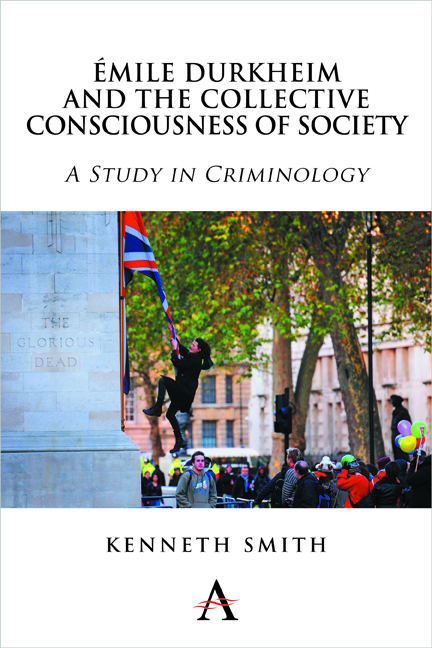Book contents
- Frontmatter
- Dedication
- Contents
- Epigraph
- Preface
- Introduction
- Part I The Concept of the Collective Consciousness of Society
- Part II The Form of the Collective Consciousness
- Preface to Part II
- Introduction to Part II: The Conditions of the Collective Consciousness of Society
- 4 The Form that the Collective Consciousness(es) of Society Takes in a Late-Industrial Society: I. Macro-sociological or ‘General’ Characteristics
- 5 The State as the ‘Organ’ of the Common Consciousness
- 6 ‘The Rule-of-Law’: A Case Study
- 7 The Form that the Collective Consciousness Takes in Early Twenty-First Century Britain: II. Micro-sociological, Individual or Small-Scale Factors
- Conclusion to Part II
- Part III Durkheim on Crime and Punishment
- Part IV Social Fact or Social Phenomenon? Durkheim's Concept of the Collective Consciousness as a ‘Social Fact’
- Part V Some Problems with Durkheim's Concept of the Common and Collective Consciousness
- Conclusion
- Appendix: On Paying a Debt to Society
- Notes
- References
- Index
5 - The State as the ‘Organ’ of the Common Consciousness
from Part II - The Form of the Collective Consciousness
Published online by Cambridge University Press: 05 October 2014
- Frontmatter
- Dedication
- Contents
- Epigraph
- Preface
- Introduction
- Part I The Concept of the Collective Consciousness of Society
- Part II The Form of the Collective Consciousness
- Preface to Part II
- Introduction to Part II: The Conditions of the Collective Consciousness of Society
- 4 The Form that the Collective Consciousness(es) of Society Takes in a Late-Industrial Society: I. Macro-sociological or ‘General’ Characteristics
- 5 The State as the ‘Organ’ of the Common Consciousness
- 6 ‘The Rule-of-Law’: A Case Study
- 7 The Form that the Collective Consciousness Takes in Early Twenty-First Century Britain: II. Micro-sociological, Individual or Small-Scale Factors
- Conclusion to Part II
- Part III Durkheim on Crime and Punishment
- Part IV Social Fact or Social Phenomenon? Durkheim's Concept of the Collective Consciousness as a ‘Social Fact’
- Part V Some Problems with Durkheim's Concept of the Common and Collective Consciousness
- Conclusion
- Appendix: On Paying a Debt to Society
- Notes
- References
- Index
Summary
This chapter attempts to explain in detail that section of table v.1. in The Division of Labour (1989, 107–8) – reproduced again below as Fig. 5 of this study – which comes between that part of the table concerned with what Durkheim describes as rules ‘serving general purposes’ (or what I call ‘macro-sociological’ conditions of the collective consciousness) and that other part of the table (see Fig. 3 above) which Durkheim describes as rules ‘serving individual purposes’ (and which I have called the ‘micro-sociological’ features of the collective consciousness). This chapter can either be viewed as an interregnum between Chapter 4 on the subject of macro-sociological conditions of the collective consciousness and Chapter 7 on micro-sociological conditions or, as Durkheim apparently intended this himself, as the continuation of the above discussion of those rules serving general purposes which forbid acts contrary to the sentiments of the collective consciousness.
At first sight it seems impossible to say what Durkheim might have meant by the inclusion of sentiments relating to the common consciousness in table v.1 of The Division of Labour, so wide is the range of offences mentioned here – from treason at one end of the spectrum to breaches of administrative regulations at the other – and so little do these things seem to have in common with each other.
- Type
- Chapter
- Information
- Publisher: Anthem PressPrint publication year: 2014



